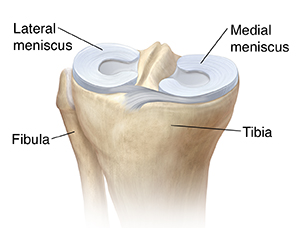Understanding Meniscal Tears
The meniscus is a tough cushion of fibrous tissue called cartilage in the knee joint. It cushions the knee. It absorbs shock and helps spread weight across the knee joint. It also works with other parts of the knee to help keep the joint stable. Injury or aging can cause the meniscus to tear and lead to pain and problems using the knee.

What causes meniscal tears?
A sudden traumatic injury can tear the meniscus. This is often because of planting the foot and twisting the knee. You might feel a "pop" when the injury happens. Sports such as soccer, football, and basketball are often involved. Repeated actions, such as squatting, may also lead to a tear. Breakdown of the meniscus because of aging can also lead to tears. Different types of common tears are bucket handle, flap, and radial tears.
Symptoms of meniscal tears
These can include:
-
Knee pain or locking
-
Knee swelling
-
Knee stiffness
-
Catching of the knee or inability to straighten the knee
-
Unstable feeling in the knee
-
Unable to move the knee through its full range of motion
Treatment for meniscal tears
A tear is unlikely to heal on its own. You often will need surgery to repair or remove a tear. In many cases, your healthcare provider will first try treatments to help relieve symptoms. These may include:
-
Rest the knee. This means avoiding any activity that puts stress on the knee joint. These include kneeling, squatting, jogging, and climbing stairs. In some cases, you may need to use crutches for a time to keep body weight off of the knee joint.
-
Cold pack. Putting a cold pack on the knee helps reduce pain and swelling.
-
Knee brace. Bracing the knee helps support it.
-
Medicine. Prescription and over-the-counter medicines can help relieve swelling and pain.
-
Exercises. Exercises help strengthen the muscles of the leg to help support the knee joint.
If these treatments don’t help relieve symptoms or the injury is severe, you may need surgery. This can remove or repair the meniscus to relieve symptoms and restore movement.
When to call your healthcare provider
Call your healthcare provider right away if you have any of these:
-
Fever of 100.4°F (38°C) or higher, or as directed by your provider
-
Chills
-
Pain or swelling that gets worse, including pain in the calf
-
Numbness or tingling in leg or foot
-
You suddenly can’t put any weight on your leg
-
Your knee “locks”